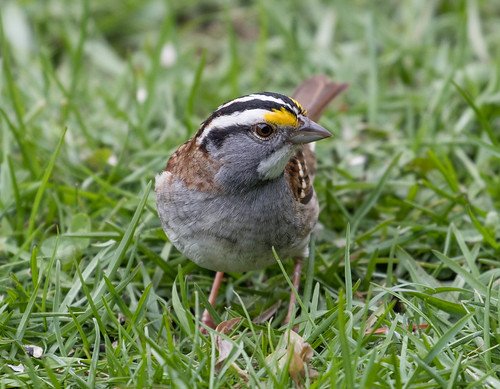Last week when I talked to the wonderful Don Kroodsma about his book, Birdsong for the Curious Naturalist, we naturally had to discuss the bird making the news right now, the White-throated Sparrow.
White-throated Sparrows have wonderful songs, don’t they? Everybody in the north country knows them, and they migrate south and people in the south also know them as they warm up singing in the spring. It’s just a delightful sound.
There have been anecdotes about a standard White-throated Poor Sam Peabody, a certain style of song, disappearing. There are anecdotes of things that have changed over the years, but nobody has kept track of this carefully until Ken Otter at the University of Northern British Columbia started recording these birds and looked into all the recordings that have been made over the years and has documented how that Peabody triplet is being replaced by a doublet that seems to have begun on the West Coast, and is headed east.
In the book, I provide some examples from Minnesota, Michigan and Ontario, of those Western doublets, and then the Eastern triplets I have Massachusetts, Vermont, and Maine. [Listen to Don's recordings here.](http://birdsongforthecurious.com/recording.php?page=93) And somewhere between New England and western Ontario these songs seem to be marching to the east. It really is a delightful phenomenon because the song is so noticeable everybody knows the song, everybody can hear what’s going on with these songs.
People who study these kinds of things call this “cultural evolution.” These songbirds learn their songs just like we learn to speak, and so they have options as to which songs they sing. And it is culture, it’s an oral tradition, these songs passed on from one generation to the next. The reason the White-throated Sparrow is so fascinating is because everyone can hear it. But these things are going on in other species, too, like the Chestnut-sided Warbler. Probably the ultimate example, that has been known for some time about very rapid cultural evolution is with humpbacked whales, where the males seem to be continuously changing their songs to match others in the singing population. And that’s the same with Three-wattled Bellbirds that we discovered in Costa Rica, so this cultural evolution is occurring in a lot of species, but it’s so exciting in the White-throated Sparrow because everybody can hear it.
Most of the news reports I’ve read about the new White-throated Sparrow song say the males are picking up this new song because the females prefer it. But these stories leave out an important detail unique to White-throated Sparrows. This species comes in two color forms—half have tan and half have white stripes on their heads. Over 97 percent of all pairs of White-throated Sparrows include one tan- and one white-striped bird. All males sing, but half the females, the ones with white stripes, sing, too.
I don’t know of any other species that has this kind of system, and the fact that the female sings is somewhat missing from this White-throated Sparrow doublets/triplets story because the females are also singing, so the explanation that maybe the males are switching to this new song because the females are impressed with it doesn’t quite fly because she sings, too. What gives?
All the recordings that would be in the archives would be of “a” White-throated Sparrow singing, regardless of the color of the crown, and so nothing is known about how these doublet songs are proceeding with respect to crown color and sex.
People living in the North woods may still be hearing White-throated Sparrows, and those of us living in inappropriate habitat will soon be seeing them back at our feeders as migration begins. I asked Don what we should be listening for in August and September. He said young birds will be practicing.
It’s the same beautiful, pure whistle, but often those whistles are wavering, and the bird is unclear. Eventually he may sing a high Poor Sam Peabod, Peabod. Eventually he will settle on just one song. A few birds sing two different songs, but mostly he’ll settle on one particular song with rhythm and the frequency changes in a predictable way, but not so the young bird migrating through, coming through in the fall. He’s uncertain whether that first note needs to be higher or lower than the second one and maybe he’ll sing just one note of—in Minnesota it would be the doublet now. Maybe he’ll sing a doublet. But he’s very uncertain. He’s practicing, and eventually, of course, he’ll get it right. You’ll hear a lot of this same uncertainty again in the spring. It’s unclear whether those are first-year birds or older birds, male or female. It’s wonderful to listen to the uncertainty as these birds practice their songs.
I happen to live on Peabody Street specifically because when I was walking through the neighborhood looking for houses for sale in early 1981, I turned at the street sign because of White-throated Sparrows. Dealing without that lovely triplet seems sad to me, and Don agrees.
I’m kind of sad, Laura—I like the Peabody or as I also like the mnemonic, Oh, sweet Canada, Canada, Canada.
I guess here in Minnesota we’ll now be able to use the mnemonic, Ya sure, you betch, you betch, you betch.


